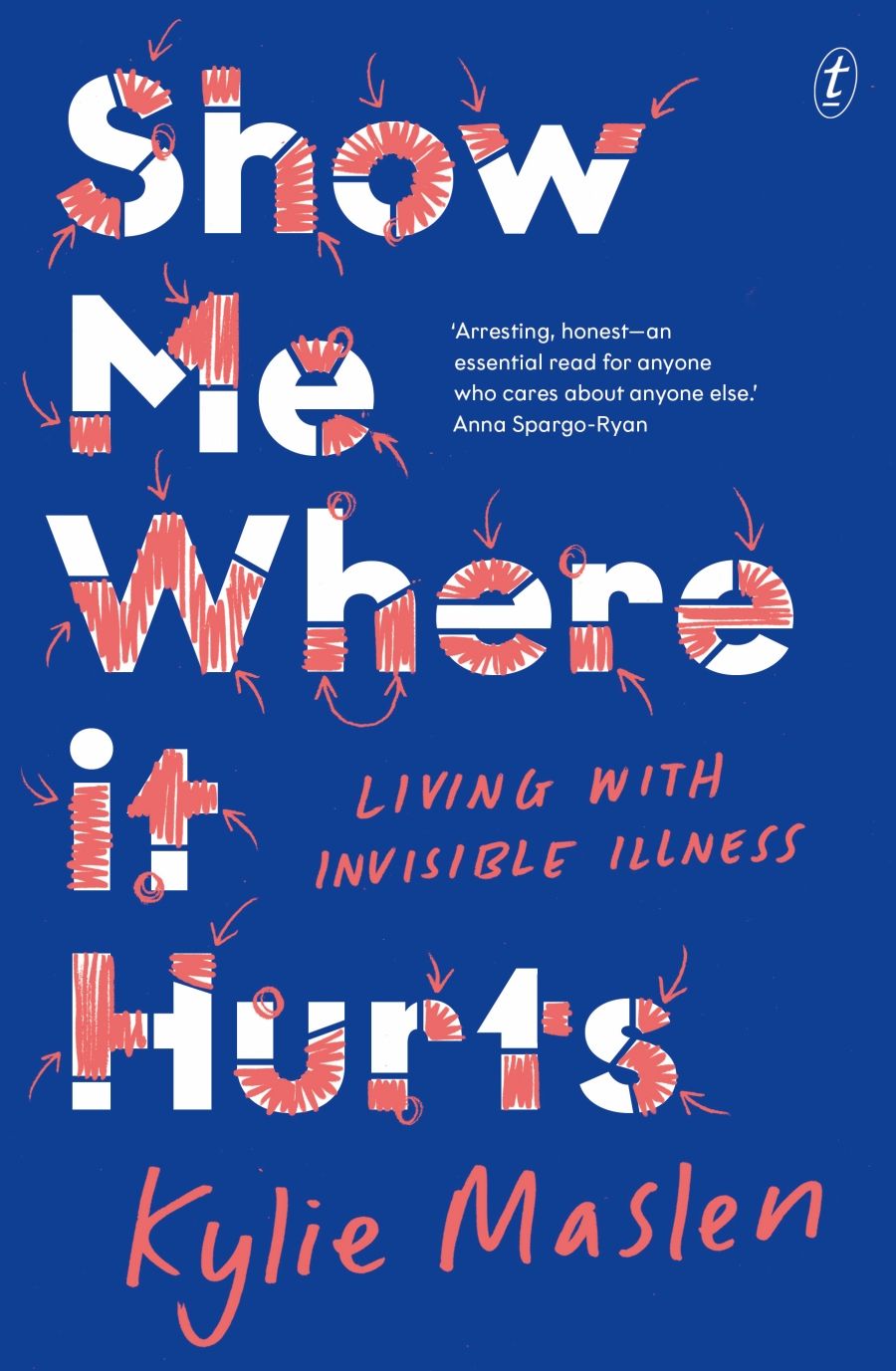
- Free Article: No
- Contents Category: Memoir
- Review Article: Yes
- Article Title: Living the unspeakable
- Article Subtitle: A new book on communicating pain
- Online Only: No
- Custom Highlight Text:
Virginia Woolf wrote that when trying to communicate about pain as a sick woman ‘language at once runs dry’. How does one talk about wounds without fetishising their workings, and how in a society where pain is taboo does one speak of it authentically? In Show Me Where it Hurts, writer and journalist Kylie Maslen balances the difficulty of this equation: telling the story of her disability and having that story remain fundamentally unspeakable. The act of telling remains for Maslen ‘a rejection of language’, and yet the thing on the table for those suffering is ‘the desire to make ourselves known’.
- Grid Image (300px * 250px):

- Book 1 Title: Show Me Where It Hurts
- Book 1 Subtitle: Living with invisible illness
- Book 1 Biblio: Text Publishing, $34.99 pb, 286 pp
- Book 1 Readings Link: booktopia.kh4ffx.net/xBZWy
The abject inadequacy of the medical model’s diagnostic approach to pain management is laid bare. Maslen has been confronting this deadly untranslatability between qualitative and quantitative languages for half her life. She is given diagnoses of polycystic ovary syndrome and endometriosis. A Janus face appears in each aspect of the equation. Maslen writes that having little control over your body means having to surrender to it. Equally, ‘the limitations of my body force me to make stronger decisions … to work toward the life I want rather than one created by compromise’. In this quest, ‘we know that words are not enough’, and neither are numbers. So, what do you do when the scale is unfit for purpose, when nothing adds up?
Enter SpongeBob SquarePants: generous, kind-hearted sea sponge and cartoon luminary. If numbers are the spectre of this piece, images enact processes of re-envisaging the invisible. For Maslen and others with chronic illnesses, animation and memes can bridge gaps across the unsayable – humour that is ‘simultaneously distant and close’. Memes, photographs, and tattoos are the etchings on screen and skin that facilitate mutual understandings around illness and assist its daily management. And we are sitting with Maslen, experiencing what it’s like to live in a world not established for your needs. A world in which television shows and tattoo artists offer wisdom and consolation where medical practitioners fail.
The visual speaks, and the removal of agency is reclaimed through needle and ink. This goes for pleasure, too, and the sense of touch that recoups losses from surgeries and miscommunications. Maslen feels the inked needle pierce her skin by choice. She touches her scars. She tunes out the voice of her lover to focus on how good her body feels after sex. ‘What I want now isn’t sympathy – I want to be devoured.’
Towards the end of the book, Bipolar II, a later diagnosis for Maslen, offers a sense of the hard-won moments of well-being that may come from right naming. Friends and family rally around her: they shine. One of the many urgencies of this book is its challenge to the ideal of self-sufficiency. The invisibility – the phantom-like quality of pain – moves to the realm of societal sickness.
 Kylie Maslen (Lauren Connolly/Text)
Kylie Maslen (Lauren Connolly/Text)
Maslen is at the height of her powers when casting a journalist’s eye over the long-term negative effects of punitive social policies. The unspeakable scale, the one-through-ten of the pain metric, is transposed into the hard numbers of deprivation. One in eight Australians live in poverty, while inflation and unaffordable housing keep the most vulnerable unable to escape the cycle of disadvantage. She addresses race, homelessness among older women, and the reality of earning a wage with a disability. Acknowledged from the book’s outset is how much harder all of these things are for people with disabilities who are trans or intersex. By interrogating the invisible in the personal sphere, these numbers become transparent. The lives of those on society’s margins come to the fore.
In the face of federal funding cuts to services utilised by the most vulnerable populations in Australian society, a reciprocity of care and trust might emerge in digital and physical communities that would extend beyond working age into retirement. Maslen talks about how people can ask for help and about the possibility of the general population stepping ‘into the void’ left by government. She offers a reimagining of care networks and the means through which complex and varied needs are met.
In a climate that has exposed how interdependent we all are for health and survival, this work feels prescient. Alongside Kate Middleton’s Calibre essay ‘The Dolorimeter’, you might call this the beginnings of an Empathy Exams for the Australian psyche. Here, Maslen’s words do not run dry. Show Me Where it Hurts is essential reading for those of us with the privilege of having a body that behaves itself, and anyone who seeks to better love and care for others.


Comments powered by CComment